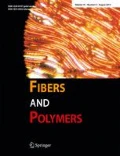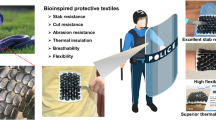Abstract
The creasing characteristic of fabrics is affected by many factors like yarn twist, fabric density, fabric constructions, fabric thickness apart from the fiber type. In the first part of this study, the effect of yarn fineness, yarn twist, fabric tightness and weave construction factors on crease recovery was studied. In the second part of the study, in order to improve the creasing recovery of the fabrics, shape memory alloy (SMA) wires were used and the effect of shape memory alloy (SMA) wire on the crease recovery of cotton fabrics produced with different types of weave constructions were determined. Due to the high cost of SMA wire and the weaving operation adversity the two experimental plans were designed according to Taguchi design of experiment (TDOE). From the analysis of the first part, it was found that the yarn linear density had the greatest effect on fabric crease recovery compare to others. Twist coefficient was the second, weft density was third and the weave construction had the least significant effect on the crease recovery. The fabrics produced with coarser and low twisted yarns with high tightness and longer floats in the weave construction have higher crease recovery property. In the second part of the study, the application of the SMA wire significantly increased the crease recovery angle of the fabrics. The thickness of the SMA wire is very important and the effect depends on the wire thickness. The increase of the SMA wire thickness increases the crease recovery significantly. However it must be appropriate with the yarn and fabric properties. The distance between the SMA wire distances was expected to increase the crease recovery however the effect was found not significant. The fabrics produced with coarser yarns with longer floats in the weave construction have higher crease recovery property. However, statistically the effects of these parameters were found not significant due to the dominant effect of the wire thickness.
Similar content being viewed by others
References
B. K. Behera and P. K. Hari, “Woven Textile Structure”, 1st ed., pp.197–204, The Textile Institute, Woodhead Publishing Limited, Cambridge, 2010.
J. F. Krasny and A. M. Sookne, Text. Res. J., 25, 493 (1955).
J. F. Krasny, G. D. Mallory, J. K. Phillips, and A. M. Sookne, Text. Res. J., 25, 499 (1955).
N. Özdil, “The Physical Quality Control Methods of Fabrics”, 1st ed., pp.105–107, Ege University Textile and Apparel Research-Application Center, Izmir, 2003.
ISO, “Determination of the Recovery From Creasing of a Horizontally Folded Specimen of Fabric by Measuring the Angle of Recovery”, pp.3–6, ISO Test Method 2313-1972, 2010.
S. Vasile, J. Githaiga, and I. L. Ciesielska-Wróbel, Fibres Text. East. Eur., 19, 41 (2011).
J. Hu, “Shape Memory Polymers and Textiles”, 1st ed., pp.3–25, The Textile Institute, Woodhead Publishing Limited, Cambridge, 2007.
A. Bedeloglu, J. Text. Eng., 83, 27 (2011).
J. M. Jani, M. Leary, A. Subic, and M. A. Gibson, Mater. Des., 56, 1078 (2014).
R. Tonndorf, M. Kirsten, R. D. Hund, and C. Cherif, Text. Res. J., 85, 1305 (2015).
A. Akdogan and K. Nurveren, Eng. Mac., 521, 35 (2003).
S. Mavruz and R. T. Ogulata, Fibres Text. East. Eur., 18, 78 (2010).
L. Onal, M. Zeydan, M. Korkmaz, and S. Meeran, Text. Res. J., 79, 468 (2009).
T. Hussain, Z. A. Malik, Z. Arshad, and A. Nazir, J. Text. Inst., 106, 934 (2015).
G. A. A. Nassif, Life Sci. J., 9, 1326 (2012).
M. Mori and M. Matsudaira, Res. J. Text. Appar., 11, 71 (2007).
Z. Değirmenci and N. Çelik, J. Indus. Text., 44, 245 (2014).
S. Vasile, K. E. Grabowska, I. L. Ciesielska, and J. Githaiga, Fibres Text. East. Eur., 18, 64 (2010).
Author information
Authors and Affiliations
Corresponding author
Rights and permissions
About this article
Cite this article
Altaş, S., Yılmaz, E. Prediction of the fabric’s crease recovery property with Taguchi design of experiment. Fibers Polym 17, 644–650 (2016). https://doi.org/10.1007/s12221-016-6199-z
Received:
Revised:
Accepted:
Published:
Issue Date:
DOI: https://doi.org/10.1007/s12221-016-6199-z




